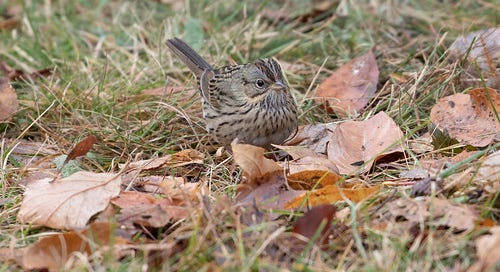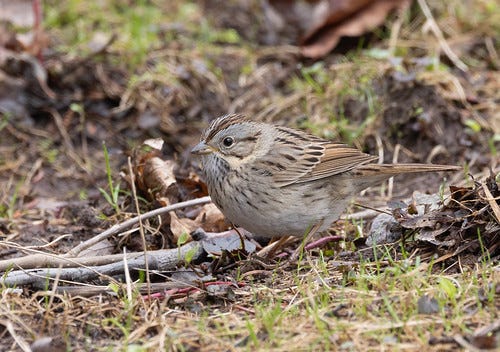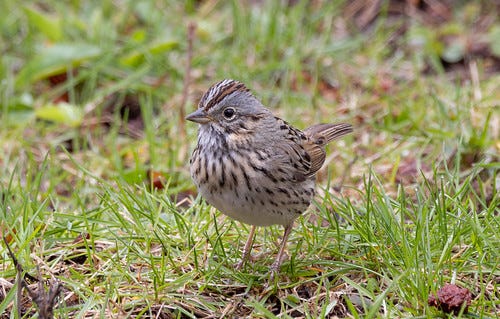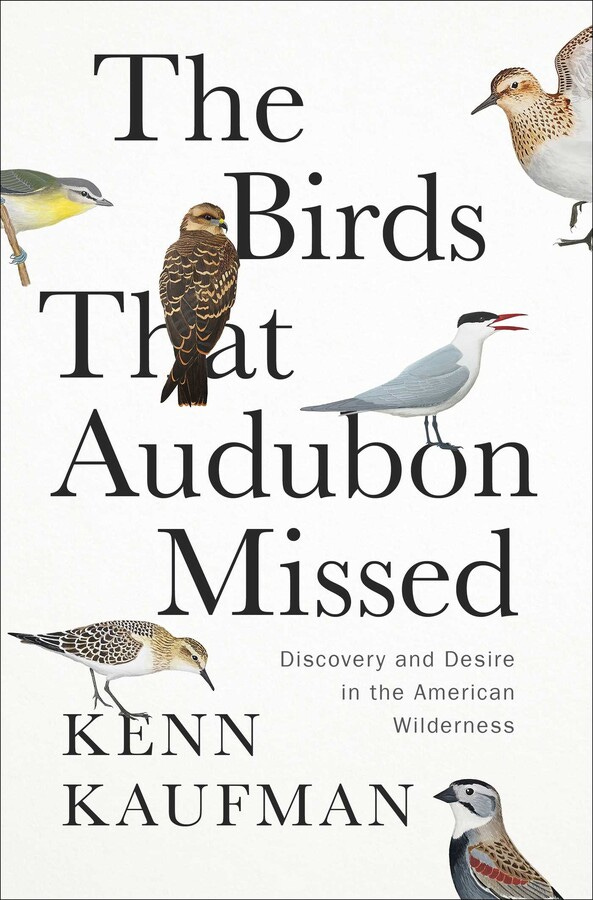Lincoln's Sparrow
A lovely little sparrow deserves a name that acknowledges its life, not death.
(Listen to the radio version here.)
On September 4, 1977, when I was birding along Quarry Road in Port Wing, Wisconsin, I came upon a pretty little sparrow I’d never seen before. It had the same kind of breast streaks coalescing in a central spot as a Fox or Song Sparrow, but it looked as if the artist who painted sparrows used a much finer brush on this one. Midwestern Fox Sparrows are rich, foxy brown; Song Sparrows come in either mostly cool, dark grays or warmer browns. This little bird’s soft cool-gray facial markings and narrow central crown stripe contrasted beautifully with delicate buffy eye-rings, its warm, deep chestnut crown infused with black streaks, and its rich chestnut primary wing and tail feathers.
I’d studied Arthur Singer’s drawings in my trusty Golden Guide for many months, so I recognized that first Lincoln’s Sparrow right away, but the flesh-and-blood bird vastly surpassed the illustration.
To this day, I’ve never seen an illustration of Lincoln’s Sparrow that captures the bird’s real-life beauty. Many photographs show the bird’s head feathers raised in a slightly agitated display, probably provoked by the photographer’s presence.
I prefer seeing them in a calmer state, their head feathers relaxed.
Descriptions of the bird’s song never quite hit the mark, either. As with its plumage, Lincoln’s Sparrows combine rich warbled tones with thin, lovely trills. (You can hear a minute-and-a-half recording of one singing in my backyard on May 11, 2022 here.)
Unlike Song Sparrows, Lincoln’s Sparrows show little geographical variation in their songs. In lab studies, females appear to select males based on their song, but not for any musical qualities—what the females are listening for is a male who sings very early on the coldest mornings, a good indication that he’s in excellent condition.
On September 4, 1981, during the first autumn after we moved to Duluth, I saw my first Minnesota Lincoln’s Sparrow on Park Point. That same October 1, I saw one in our own backyard, and I’ve seen at least one or two, sometimes several, on Peabody Street during every one of the 85 spring and fall migration periods since then.
They’re hardly abundant migrants and they’re shy and secretive, but they’re genuinely common in the Midwest. They breed throughout most of Canada and Alaska, down into the western mountains, and along the northernmost parts of the Midwestern and eastern states. In my neck of the woods, they nest in bogs and brushy, wet meadows where the buzzy whine of mosquitoes can make it hard to hear them at the break of dawn. They migrate through most of the United States and spend winter along the Pacific Coast, in the Southwest, and all along the Gulf Coast. I’ve seen Lincoln’s Sparrows in at least 13 states and provinces.
Especially when I was a new birder, whenever I added a new bird to my life list, I researched as much about it as I could. Much of what I learned about Lincoln’s Sparrow was accurate and increased my appreciation of this elusive species. But one thing I read in several books, which I repeated several times on “For the Birds,” is that John James Audubon discovered Lincoln’s Sparrow, naming it for “young Tom Lincoln,” who shot the specimens Audubon used to paint the bird and substantiate his “discovery.” I accepted that as straightforward fact.
I wondered about Audubon’s description of the bird, calling it “petulant and pugnacious,” when the Lincoln’s Sparrows I observed seemed to get along well with sparrows of their own kind and other species in the mixed flocks I saw during migration. Since Audubon never seemed aware that the species even existed until Thomas Lincoln shot some for him, I wondered if wounded birds being manhandled might be forgiven for a bit of petulance and pugnaciousness.
I didn’t delve much into Audubon’s writing because it was too much about shooting, but as a beginning birder, I pretty much believed everything I read in the ornithological literature, especially if it had the name Audubon on it, including suggestions that he had “discovered” various birds. I of course knew that Native Americans didn’t have a written language, and that the white male Europeans who settled here did their best to prevent most white women and non-white people of either sex from learning to read or write while not showing much interest in communicating with many of them in any other way, but I didn’t quite grok what that meant: that there were worlds of knowledge and understanding that those literate white men refused to access or acknowledge, including enormous swaths of information about North American birds that would never make it into the ornithological literature.
We’ll never know how aware Native peoples were of these lovely yet unassuming birds, whether they heard their song as a sign of the progression of spring, an indication of a good spot to find a particular food item, or anything else. We have no clue at this late date what names various peoples may have called this lovely bird, though I sincerely doubt anyone but a Eurocentric white male would name a beautiful little songster for a young guy who shot a bunch of them.
I’ve been thinking about Lincoln’s Sparrow a lot in the past few weeks for two reasons: they’ve been visiting my backyard, giving me opportunities to watch, listen, and photograph them; and also because I was given a sneak peek preview of a fantastic new book that just came out last week, written by one of my favorite authors, Kenn Kaufman: The Birds That Audubon Missed: Discovery and Desire in the American Wilderness.
I didn’t have to get as far as Chapter One to know how much I’d love this book—Kenn begins the Prologue with Audubon’s 1833 voyage to Labrador and his “discovery” of this beloved bird of mine, filling in details I hadn’t known and asking some questions that, in retrospect, seem so obvious that I’m shocked that I never thought about them before—such as how such a common bird over so much of the Thirteen Colonies and the early United States, including the area of New Orleans where Audubon spent so much of his lifetime, had eluded not just Audubon’s attention until he was 48 years old but also the other bird collectors racing to name as many American birds as they possibly could.
My review of Kenn Kaufman’s book is for another post. I don’t have the right words, nor did John James Audubon himself, to speak for this beautiful, sweet bird. So I’ll give the final word to a Lincoln’s Sparrow I recorded in my backyard in 2022.













